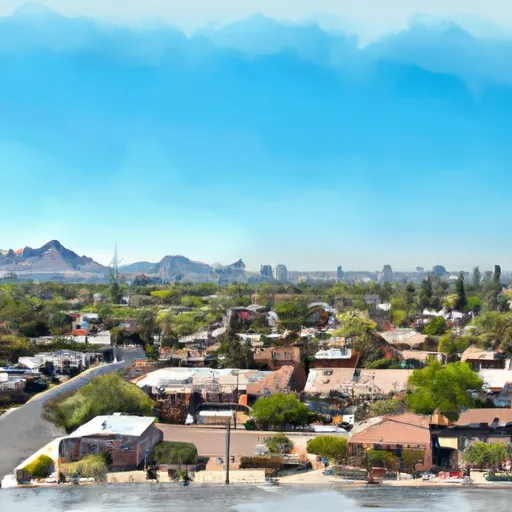-
 Snoflo Premium
Snoflo Premium
Get unlimited access to all our content
With no Ad interruptions! - Start Your Free Trial Login with existing account
Litchfield-Park
Eden Index
Climate
7.6
•
Recreation
2.8
•
Community
4.6
•
Safeguard
5.2/10

Litchfield Park, Arizona is a charming community located in Maricopa County, just outside of Phoenix. Known for its small-town atmosphere and beautiful landscapes, Litchfield Park offers a unique blend of suburban living and natural beauty.
The climate in Litchfield Park is typically arid, with hot summers and mild winters. The area experiences long, sunny days with little rainfall throughout the year. Summers can be extremely hot, with temperatures often exceeding 100°F (37°C), while winter temperatures average around 65°F (18°C).
Hydrologically, Litchfield Park is part of the larger Salt River Basin. The area is characterized by its sandy desert soils and sparse vegetation, with occasional washes and dry riverbeds. The region's hydrology is primarily influenced by the Salt River and its tributaries.
When it comes to outdoor recreation, Litchfield Park offers numerous opportunities. Nearby White Tank Mountain Regional Park provides hiking trails, scenic drives, and camping sites. Residents and visitors can also enjoy golfing at the Wigwam Resort, which boasts three championship golf courses. The city also hosts several community events and festivals throughout the year, including the Annual Litchfield Park Arts Festival, where visitors can enjoy art exhibits, live music, and local cuisine.
What is the Eden Index?
The Snoflo Eden Index serves as a comprehensive rating system for regions, evaluating their desirability through a holistic assessment of climate health, outdoor recreation opportunities, and natural disaster risk, acknowledging the profound impact of these factors on livability and well-being.
Climate Health Indicator (CHI): 7.6
Litchfield-Park receives approximately
200mm of rain per year,
with humidity levels near 46%
and air temperatures averaging around
22°C.
Litchfield-Park has a plant hardyness factor of
9, meaning
plants and agriculture in this region tend to thrive here all year round.
By considering the ideal temperature range, reliable water supplies, clean air, and stable seasonal rain or snowpacks, the Climate Health Indicator (CHI) underscores the significance of a healthy climate as the foundation for quality living.
A healthy climate is paramount for ensuring a high quality of life and livability in a region, fostering both physical well-being and environmental harmony. This can be characterized by ideal temperatures, reliable access to water supplies, clean air, and consistent seasonal rain or snowpacks.
Weather Forecast
Streamflow Conditions
Lower Gila-Agua Fria
Area Rivers
Lower Gila-Agua Fria
Snowpack Depths
Lower Gila-Agua Fria
Reservoir Storage Capacity
Lower Gila-Agua Fria
Groundwater Levels
Recreational Opportunity Index (ROI): 2.8
The Recreational Opportunity Index (ROI) recognizes the value of outdoor recreational options, such as parks, hiking trails, camping sites, and fishing spots, while acknowledging that climate plays a pivotal role in ensuring the comfort and consistency of these experiences.
Access to outdoor recreational opportunities, encompassing activities such as parks, hiking, camping, and fishing, is crucial for overall well-being, and the climate plays a pivotal role in enabling and enhancing these experiences, ensuring that individuals can engage in nature-based activities comfortably and consistently.
Camping Areas
| Campground | Campsites | Reservations | Toilets | Showers | Elevation |
|---|---|---|---|---|---|
| Estrella Mountain Regional Park | 7 | 913 ft | |||
| White Tank Mountain | 40 | 1,428 ft | |||
| Lake Pleasant | 150 | 1,830 ft |
Nearby Fishing
Nearby Ski Areas
Catastrophe Safeguard Index (CSI):
The Catastrophe Safeguard Index (CSI) recognizes that natural disaster risk, encompassing floods, fires, hurricanes, and tornadoes, can drastically affect safety and the overall appeal of an area.
The level of natural disaster risk in a region significantly affects safety and the overall livability, with climate change amplifying these risks by potentially increasing the frequency and intensity of events like floods, fires, hurricanes, and tornadoes, thereby posing substantial challenges to community resilience and well-being.
Community Resilience Indicator (CRI): 4.6
The Community Resilience Indicator (CRI) recognizes that education, healthcare, and socioeconomics are crucial to the well-being of a region. The CRI acknowledges the profound impact of these elements on residents' overall quality of life. By evaluating educational resources, healthcare accessibility, and economic inclusivity, the index captures the essential aspects that contribute to a thriving community, fostering resident satisfaction, equity, and social cohesion.

